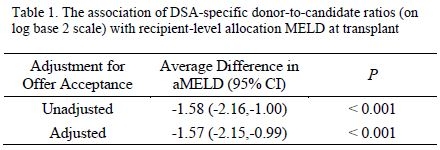Offer Acceptance Practices and Geographic Variability in Allocation MELD at Transplant
1SRTR, Minneapolis
2U.S. Navy, Anapolis.
Meeting: 2018 American Transplant Congress
Abstract number: A276
Keywords: Allocation, Liver, Procurement, Public policy
Session Information
Session Name: Poster Session A: Liver: MELD, Allocation and Donor Issues (DCD/ECD)
Session Type: Poster Session
Date: Saturday, June 2, 2018
Session Time: 5:30pm-7:30pm
 Presentation Time: 5:30pm-7:30pm
Presentation Time: 5:30pm-7:30pm
Location: Hall 4EF
Offer acceptance practices may cause geographic variability in allocation model for end-stage liver disease (aMELD) score at transplant and could magnify the apparent impact of donor supply and demand on such variability. Using SRTR data to evaluate these issues, offer acceptance practices of liver transplant programs and donation service areas (DSAs) were estimated using offers of livers from donors recovered between January 1, 2016, and December 31, 2016. The ratio of recovered livers to listed candidates in a DSA (i.e., the donor-to-candidate ratio) and aMELD at transplant was determined with listed candidates and those who underwent transplant between January 1, 2016, and December 31, 2016. Offer acceptance practices were compared with liver yield, placement of transplanted livers, donor supply and demand, and aMELD at transplant. Higher offer acceptance was associated with higher odds of liver yield (odds ratio (OR), 1.32; P < 0.01), higher odds of local placement of transplanted livers (OR, 1.34; P < 0.01), and lower aMELD at transplant (average aMELD difference, -1.62; P < 0.01). However, larger donor-to-candidate ratios was associated with a lower median aMELD at transplant (r = -0.45; P < 0.01), but not with offer acceptance (r = 0.09; P = 0.50). Additionally, the unadjusted association between DSA-level donor-to-candidate ratios and aMELD at transplant did not change after adjustment for offer acceptance (Table 1). Thus, the supply and demand of livers in a DSA is an important and independent determinant of access to transplant despite program offer acceptance practices and their association with liver yield, local placement, and aMELD at transplant.
Note: The association was estimated before and after adjusting for program-level offer acceptance ratios. The interpretation is the average difference in aMELD at transplant per doubling of the donor-to-candidate ratio.
CI, confidence interval; DSA, donation service area; aMELD, allocation model for end-stage liver disease score.
CITATION INFORMATION: Wey A., Gentry S., Pyke J., Schladt D., Weaver T., Salkowski N., Kasiske B., Israni A., Snyder J. Offer Acceptance Practices and Geographic Variability in Allocation MELD at Transplant Am J Transplant. 2017;17 (suppl 3).
To cite this abstract in AMA style:
Wey A, Gentry S, Pyke J, Schladt D, Weaver T, Salkowski N, Kasiske B, Israni A, Snyder J. Offer Acceptance Practices and Geographic Variability in Allocation MELD at Transplant [abstract]. https://atcmeetingabstracts.com/abstract/offer-acceptance-practices-and-geographic-variability-in-allocation-meld-at-transplant/. Accessed December 12, 2025.« Back to 2018 American Transplant Congress

